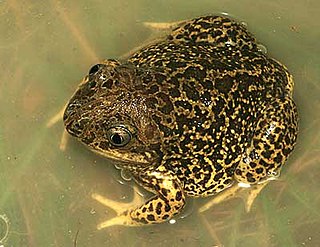
Philautus is a genus of shrub frogs in the family Rhacophoridae from Asia. Some species in this genus are now considered extinct by IUCN, while others are widespread and abundant. The taxonomy of the group is unclear, with many poorly described species.

Theloderma, the bug-eyed frogs, mossy frogs or warty frogs, is a genus of frogs in the family Rhacophoridae, subfamily Rhacophorinae. They are found from northeastern India and southern China, through Southeast Asia, to the Greater Sunda Islands; the highest species richness is in Indochina. Some species, especially T. corticale, are sometimes kept in captivity.

Rhacophorus is a genus of frogs in the shrub frog family (Rhacophoridae) and the related Hylidae make up the true tree frogs. They are found in India, Japan, Madagascar, Africa, and Southeast Asia. Over 40 species are currently recognised.
Aubria is a small genus of frogs, with two known species. All members of this genus are found in West Africa. Their common name is ball frogs or fishing frogs.

Micrixalus is a genus of frogs from that are endemic to the Western Ghats in India. They are monotypic within the family Micrixalidae. Before being raised to the family level they were classified as the subfamily Micrixalinae within Ranidae. Micrixalus frogs are popularly known as "dancing frogs" due to their peculiar habit of waving their feet to attract females during the breeding season. Dancing frogs are extremely vulnerable as their habitat is severely threatened.

Ptychadena is a genus of frogs in the grassland frog family, Ptychadenidae. They are distributed in Sub-Saharan Africa as well as nilotic Egypt. The common names of this genus are ridged frogs and grass frogs.

Sphaerotheca is a genus of true frogs. They can be found in South Asia. Molecular data suggest that they are closely related to Fejervarya, perhaps as a monophyletic group within a paraphyletic Fejervarya.

Leptolalax is a genus of frogs in the family Megophryidae. They are sometimes known as Asian toads, metacarpal-tubercled toads, or slender litter frogs, although many species-specific common names do not follow these conventions, and many species do not have common names. They are widely distributed in southeastern and eastern Asia, from southern China and northeastern India to the Malay Peninsula and Borneo. Leptolalax are typically small and have a cryptic colour pattern and no obvious morphological characters useful in systematic studies. Consequently, both molecular genetic analyses and analysis of advertisement calls by male frogs have been important in identifying new species.
Ophryophryne hansi is a species of frog in the family Megophryidae. It is found in Cambodia, Laos, and Vietnam. Its natural habitats are subtropical or tropical moist lowland forests and rivers. It is threatened by habitat loss.
Ophryophryne microstoma is a species of frog in the family Megophryidae. It is found in Cambodia, China, Laos, Thailand, and Vietnam. Its natural habitats are subtropical or tropical moist lowland forests, subtropical or tropical moist montane forests, rivers, and swamps. It is threatened by habitat loss.

Xenophrys is a genus of amphibians in the family Megophryidae. They are found in southeastern Asia to Borneo. Their common name is strange-horned toads.

Phrynobatrachus is a genus of Sub-Saharan frogs that form the monogeneric family Phrynobatrachidae. Their common name is puddle frogs, dwarf puddle frogs, African puddle frogs, or African river frogs. The common name, puddle frog, refers to the fact that many species breed in temporary waterbodies such as puddles.

Minervarya is a genus of frogs in the family Dicroglossidae. Species of this genus have been found from eastern India, including the Andaman Islands to northern Thailand.

The Pelobatoidea are a superfamily of frogs. They typically combine a toad-like body shape with a frog-like, pointed face. Phylogenetically they stand between primitive frogs on the one side and higher frogs on the other and are therefore – among other things by characteristics of bone construction – in the suborder Mesobatrachia.

Sylvirana is a genus of true frogs, family Ranidae, found in South and East Asia, from northeastern India in west to China in the north, Taiwan in the east, and Thailand in the south. Originally proposed as a subgenus of Rana in 1992, it has been considered both a full genus and a synonym of Hylarana. Its current recognition at generic level stems from molecular genetic analyses published in 2015.

Gracixalus is a genus of shrub frogs from south-eastern Asia.
Ophryophryne synoria is a species of frog in the family Megophryidae. It is only known from its type locality in eastern Cambodia and from southern Vietnam. Common names O'Reang horned frog and O'Reang mountain toad have been proposed for it.
Annemarie Ohler is an Austrian herpetologist and professor who concentrates on the taxonomy of amphibians. She has 3,602 citations and an h-index of 36.

Zhangixalus is a genus of frogs in the subfamily Rhacophorinae, family Rhacophoridae. They are collectively known as Zhang's treefrogs. They occur in the Eastern Himalayas, southern China, Taiwan, Japan, and southeast Asia.

Boulenophrys is a genus of frogs in the family Megophryidae. They occur in the China, Mainland Southeast Asia and Northeast India. It had been placed variously as a subgenus or synonymy of Megophrys. Dubois, Ohler and Pyron first recognized that Panophrys is proccupied and employed Boulenophrys as the generic name rather than Tianophrys under the Principle of First Revisor.














